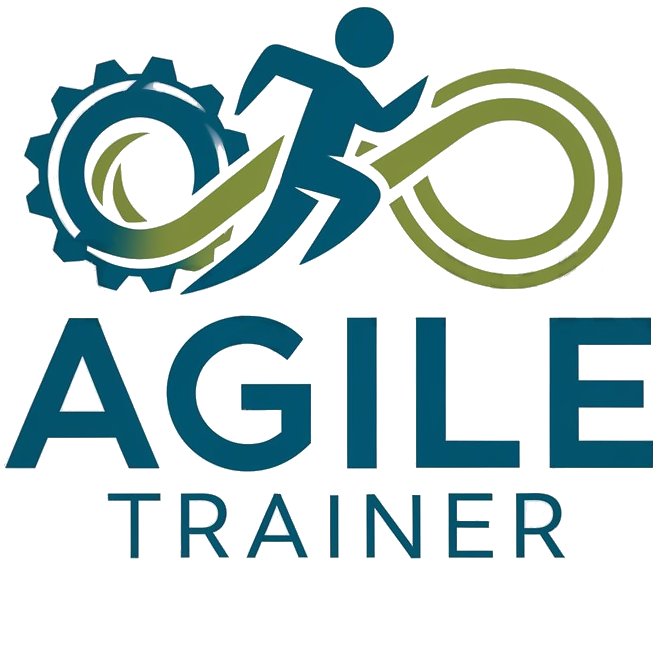Agile Frameworks and Their Rules for Organizations
Agile frameworks like SAFe provide guidelines and structures for agile collaboration within an organization. Using these models allows companies to act faster, respond more flexibly, and work more innovatively.
Overview of Agile Frameworks
Agile frameworks set standards for implementing agile principles and values, consisting of several core elements:
- Roles and Structures: They provide an organizational framework that regulates team structure and role distribution within the organization.
- Meetings and Processes: They define how teams interact and work together regularly.
- Tools and Artifacts: They specify the tools that help teams and organizations organize and conduct their work efficiently.
These frameworks promote working in cross-functional teams, continuous customer involvement, self-organization, and the regular delivery of finished product units.
Benefits of Agile Frameworks
Agile frameworks allow agile methods to be applied to specific areas or the entire organization. They tackle the challenge of aligning an organization towards common goals while strengthening the self-organization and autonomy of teams. By using agile frameworks, organizations can achieve several benefits:
- Speed: Faster time to market for products.
- Adaptability: Better response to changes and challenges.
- Customer Proximity and Innovation: Closer customer relationships lead to higher innovation capacity.
- Employee Retention: Greater autonomy and responsibility strengthen employee loyalty.
- Recruitment: Better competitiveness in attracting qualified professionals.
Agile Frameworks Beyond Software Companies
Agile frameworks originated in IT and software development, which is why models like SAFe or Scrum are particularly common in digital and IT organizations. However, most frameworks are universally applicable. For digital business models or companies whose value creation is based on software or IT, agile frameworks are indispensable. In other industries and business models, they are particularly useful under the following conditions:
- Complexity: The organization must handle complex tasks with many variables and dependencies.
- Uncertainty: Constant changes and new requirements characterize the work environment.
In a VUCA world (volatility, uncertainty, complexity, ambiguity), agile methods have become almost indispensable.
Classification of Agile Frameworks
The variety of agile tools and methods can be overwhelming. Although the boundaries are often fluid, agile approaches can be categorized into different types:
- Agile Practices: Simple tools, comparable to ingredients in a recipe.
- Agile Methods: Specific approaches for teams, comparable to a recipe.
- Agile Frameworks: Structure and processes for the entire organization, comparable to a comprehensive diet plan.
While these distinctions are not always clear, they provide helpful orientation.
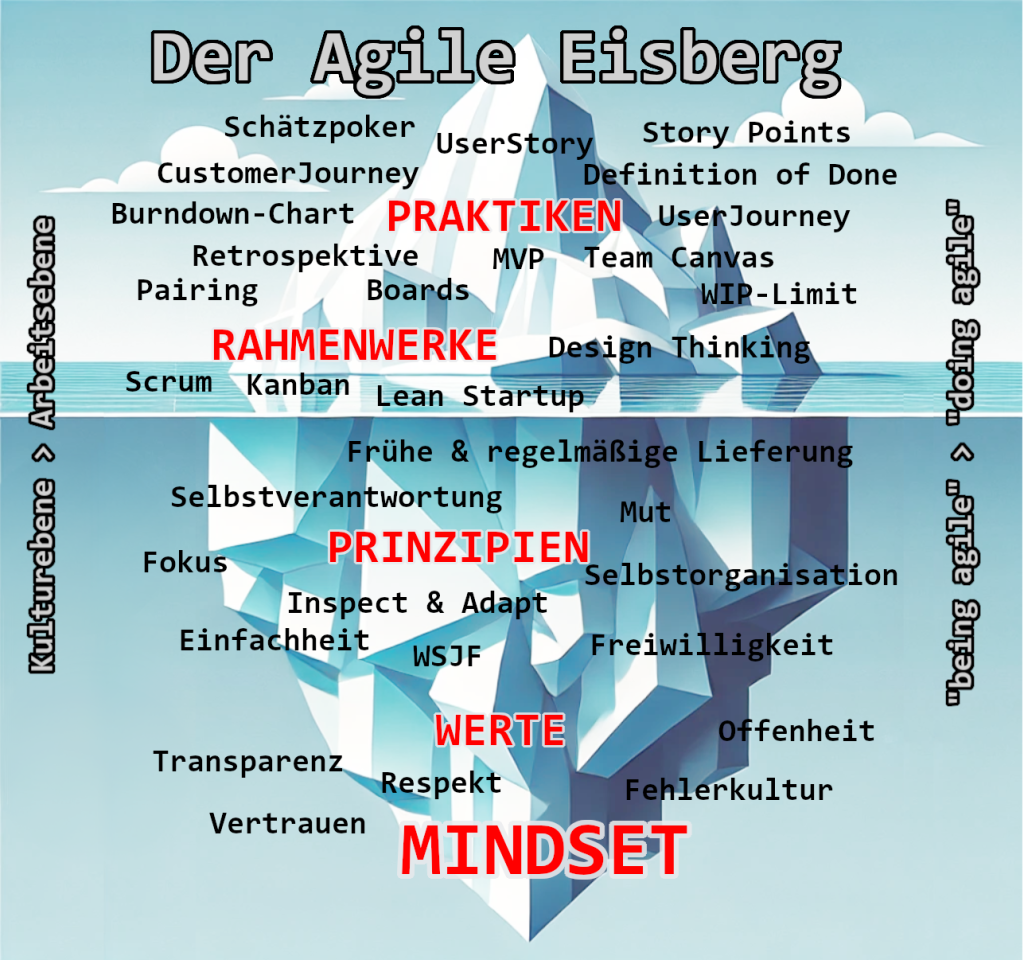
The Most Important Agile Frameworks
Here are the most important agile frameworks, starting with the three technically oriented models that are particularly relevant for digital, IT, and software organizations, followed by OKR and the Spotify model, which can be used alongside other frameworks, and other frameworks that directly influence organizational and leadership structures.
- Scrum
- Scaled Scrum (LeSS, Scrum@Scale, Nexus)
- SAFe
- Objectives & Key Results (OKR)
- Spotify Model
- Dual Organization
- Holacracy
1. Scrum (for individual teams up to 10 people)
Scrum is the best-known agile framework used for product development. It helps teams tackle complex tasks in short, manageable cycles and continuously deliver value. The core idea is to enable quick adjustments and continuous learning through iterative work.
Key Aspects of Scrum:
- Sprints: Time-limited cycles of 1-4 weeks in which a functional product increment is developed.
- Daily Stand-Up: A short, daily meeting to discuss progress and clear obstacles.
- Review and Retrospective: After each sprint, a review is held to present the product increment, followed by a retrospective to improve the process.
Roles in Scrum:
- Product Owner: Responsible for the product vision and prioritizing requirements in the product backlog.
- Scrum Master: Supports the team and ensures that the Scrum rules are followed.
- Developers: Work self-organized to achieve the sprint goal.
Advantages of Scrum:
- Flexibility and Adaptability: Quick response to changes through short sprints.
- Transparency: Regular meetings and clear goals create transparency about progress.
- Customer Focus: Regular feedback loops ensure that the product meets customer needs.
Summary: Scrum enables teams to work effectively in a dynamic environment by combining clear structures with flexible adaptation.
2. Scaled Scrum: LeSS, Nexus, Scrum@Scale, SAFe
The frameworks LeSS (Large Scale Scrum), Scrum@Scale, and Nexus are designed to scale Scrum for larger teams and projects. All three approaches expand the principles of Scrum to coordinate collaboration between multiple teams and develop complex products more efficiently. They introduce specific rules and structures to ensure transparency and alignment between teams.
Scaled Events:
- LeSS: Retains the standard Scrum events but extends them to a larger number of teams. It includes the Overall Sprint Review and Overall Retrospective to integrate feedback across multiple teams.
- Scrum@Scale: Expands meetings with the Executive Action Team and MetaScrum to coordinate alignment and decisions across many teams.
- Nexus: Introduces Nexus Daily Scrum, Nexus Sprint Review, and Nexus Retrospective to improve integration and coordination between teams.
Artifacts:
- LeSS: Uses a shared Product Backlog for all teams, but each team maintains its own Sprint Backlog.
- Scrum@Scale: Each Product Owner continues to manage their own backlog, coordinated through a Meta Backlog and prioritization at the enterprise level.
- Nexus: Integrates a Nexus Integration Team Backlog, focusing on integrating the work of all teams and resolving dependencies.
New Roles:
- LeSS: Does not introduce new roles but extends existing roles like the Product Owner and Scrum Master to cover multiple teams, emphasizing team self-organization.
- Scrum@Scale: Introduces the Executive Action Team (EAT) and the Chief Product Owner to enable strategic coordination across teams.
- Nexus: Adds the Nexus Integration Team, responsible for ensuring that the work of all teams is integrated and potentially deliverable.
Product Owner Responsibility:
- LeSS: The Product Owner is responsible for the shared Product Backlog across all teams and prioritizes the work for multiple teams.
- Scrum@Scale: The Chief Product Owner manages the overarching product vision, while individual Product Owners manage the backlogs of their respective teams.
- Nexus: The Product Owner manages a shared Backlog for the entire Nexus and ensures that tasks are clear for all teams.
Summary: LeSS, Scrum@Scale, and Nexus scale Scrum by introducing additional events, artifacts, and roles, and by expanding the responsibilities of the Product Owner. All three aim to ensure transparency, coordination, and integration in large agile projects, each with a different focus on scaling.
3. SAFe – Scaled Agile Framework
SAFe is a scaled agile framework aimed at applying agile methods in large companies. It combines principles of agility, lean management, design thinking, the DevOps philosophy, and systems thinking to coordinate collaboration between multiple teams and efficiently develop complex products.
Key Principles:
- Customer Focus: Emphasis on continuously delivering valuable outcomes to customers.
- Decentralized Decision-Making: Teams are empowered to act independently for quicker adaptation to changes.
- Continuous Improvement: Regular reflections and adjustments in the process ensure ongoing learning and optimization.
Levels in the SAFe Framework:
- Team Level: Agile teams work using methods like Scrum, deliver outcomes regularly, and work iteratively.
- ART Level: Multiple teams are organized into an Agile Release Train (ART), which operates in Planning Intervals (PIs) of 8-12 weeks.
- Solution Level: For large solutions that require the coordination of several ARTs, these are organized via a Solution Train.
- Portfolio Level: Strategic alignment and resource management through Lean Portfolio Management (LPM), ensuring that investments are focused on key initiatives and value streams.
Key Concepts:
- Agile Release Train (ART): Coordination of multiple teams to achieve larger goals together.
- Planning Interval (PI): A cycle that combines planning and execution, enabling team synchronization.
- DevOps and Continuous Delivery: Focus on fast delivery and a continuous flow of value.
Advantages:
- Scalability: Applicable from small teams to entire organizational structures.
- Transparency and Planning Certainty: Achieved through regular planning and synchronization.
- Efficiency Gains: Faster adaptation to changes and improved collaboration among large teams.
Summary: SAFe helps large companies to implement agile methods in a structured way, allowing them to respond flexibly to market changes while ensuring strategic focus and continuous improvement.
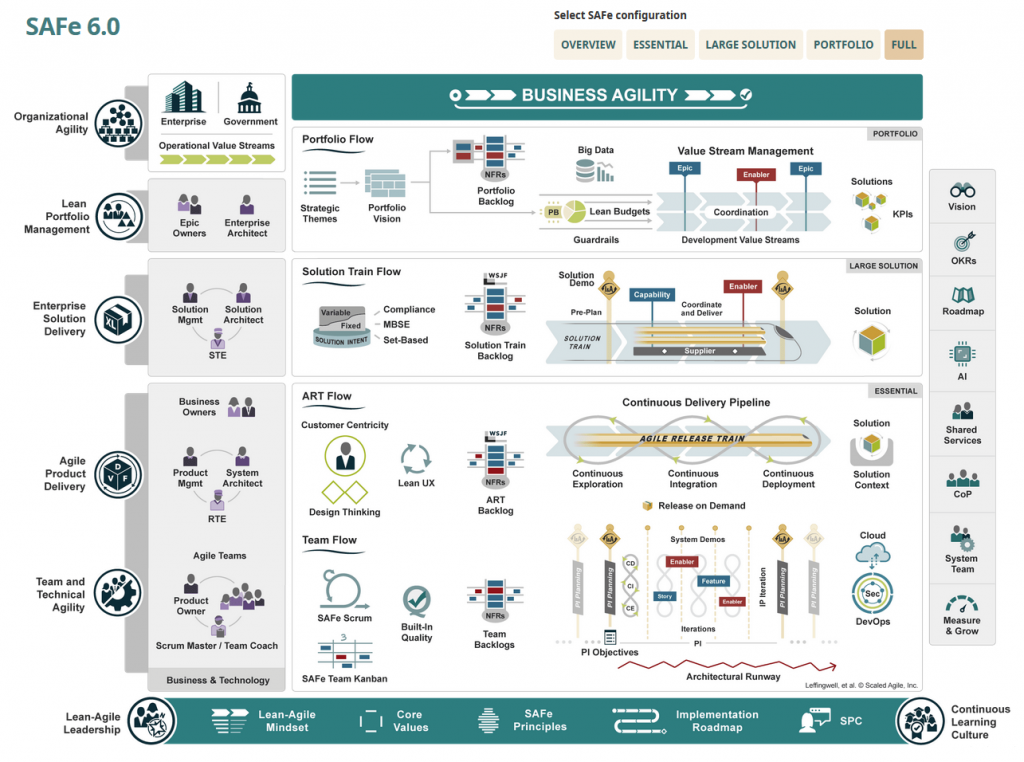
Overall overview of the SAFe Framework in version 6.0 – Source Scaled Agile Inc
4. OKR (Objectives and Key Results)
OKR (Objectives and Key Results) is a goal-setting and measurement framework that helps companies and teams set clear objectives and track progress. It was developed by Intel and later popularized by companies like Google. OKR promotes transparency, focus, and alignment across the entire organization.
Key Aspects of OKR:
- Objectives (O): These describe ambitious, qualitative goals that a team or organization aims to achieve. They are inspiring and provide clear direction.
- Key Results (KR): These are measurable criteria that indicate whether an objective has been achieved. Typically, each objective is paired with 3-5 key results that represent quantifiable milestones.
OKR Cycle:
- Cycle Duration: OKRs are typically set on a quarterly basis to allow for flexibility and quick adjustments.
- Check-ins: Regular reviews of OKRs to track progress, identify obstacles, and adjust priorities.
- Review and Retrospective: At the end of each cycle, results are reflected upon to identify successes and areas for improvement.
Advantages of OKR:
- Clear Focus: OKR helps concentrate efforts on the most important goals and use resources effectively.
- Transparency and Alignment: All employees have insight into the goals and can align their work with the overarching company strategy.
- Measurability and Motivation: Concrete key results make progress visible, enhancing motivation and providing clear criteria for success.
Summary: OKR is a simple yet powerful framework that helps companies set ambitious goals and measure their implementation. It promotes clarity, collaboration, and quick adjustments, enabling organizations to work in a focused and effective manner.
5. Spotify Model – Agile Model from Sweden
The Spotify model is named after the Swedish music service and does not actually meet the criteria to be considered a true agile framework. Even Spotify refers to it only as a temporary snapshot, which is now more than 10 years old. Nevertheless, the Spotify model still serves as inspiration for many in structuring their organization. The key components of the Spotify framework are:
- Squads: Daily work is done in cross-functional teams of 8-10 people.
- Tribes: Encompass multiple squads, with a maximum of 150 people.
- Chapters: Organize professional exchange and functional leadership across multiple squads.
- Communities: Are voluntary groups that promote employee exchange on topics of their choice.
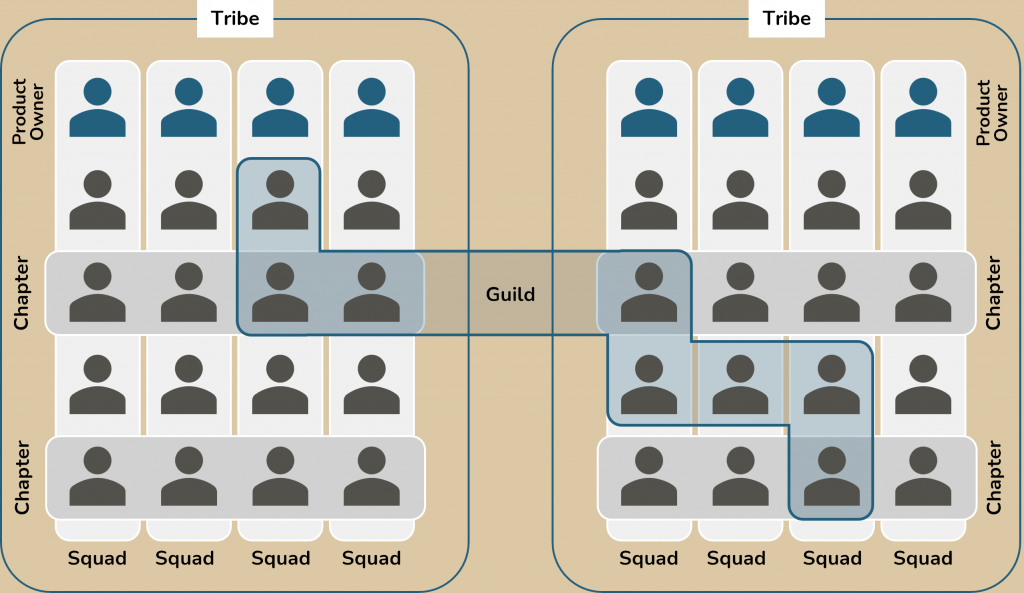
6. Dual Organization – Hierarchy and Agile Network
Similar to OKR, the dual organizational framework can be introduced without the need to restructure the entire organization. It consists of two independent structures:
- Management-Driven Hierarchy
The traditional structure that manages daily business operations. - Accelerator Network
A decentralized, non-hierarchical Value Stream Network that drives strategic initiatives and promotes innovation as well as continuous development. Employees are part of both structures, thus embodying a dual organizational model.
John Kotter has defined principles for establishing a dual organization, including:
- A shared purpose that provides clear direction for the network,
- Voluntary participation, allowing employees to choose whether to engage in the network,
- Flat structures and team autonomy,
- Sufficient time for working within the network.
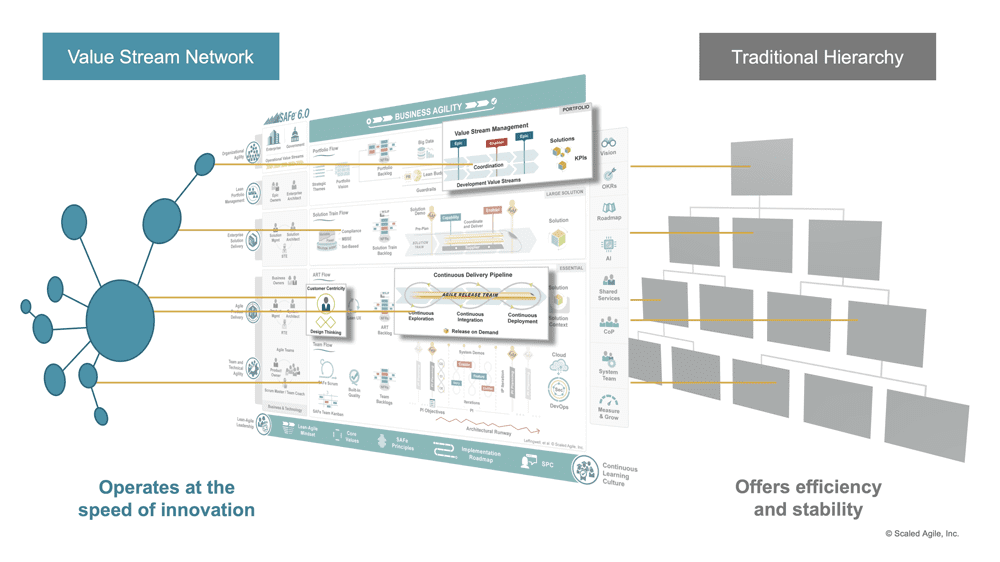
7. Holacracy – Sociocracy in “Commercial” Form
Holacracy is certainly the most comprehensive agile framework. While other agile frameworks are typically applied only in parts of a company, Holacracy is a complete operational and management system suitable for companies of any size and industry. Its most defining characteristics include:
- Organization in Roles and Circles: The Holacracy model organizes a company into roles (individuals) and circles (teams). Each employee can hold multiple roles, and the circles or teams are connected through double links.
- Meetings and Decision-Making: Holacracy relies on well-defined meeting rituals and an integrative decision-making process.
- Holacracy Constitution: Holacracy is based on a very comprehensive and transparent set of rules, documented in the Holacracy Constitution. It defines all processes and responsibilities. Similar to a democratic constitution, this is where the actual “power” resides.
The core concepts of Holacracy are closely intertwined, which is why Holacracy is an all-or-nothing approach. This means that even if an organization adopts a holacratic structure gradually across different departments, it must be implemented fully or not at all.
Choosing the Right Agile Framework
The selection of the appropriate agile framework depends on several factors:
- What is the product and business model?
- How is the current organization structured?
- What problem is the agile framework intended to solve?
- Is the organization ready for a comprehensive reorganization?
Conclusion
Agile frameworks provide a solid starting point for making an organization more agile. However, implementation always requires adjustments to the specific realities and challenges of the company. Agile frameworks offer a structure that must be adapted to the particular business situation. If adopting agile frameworks seems premature, the Flight Levels Model by Klaus Leopold could provide a foundation for understanding the implementation of agility within a company.
Contact us if you wish to use our consulting or coaching services!
